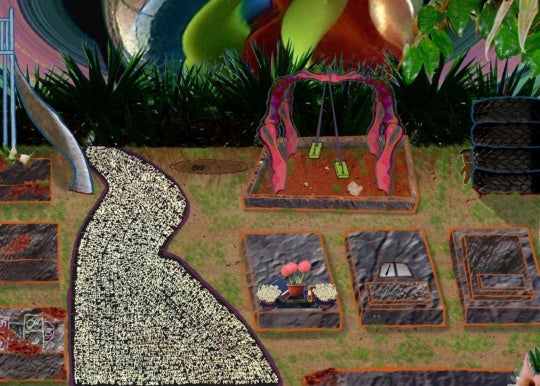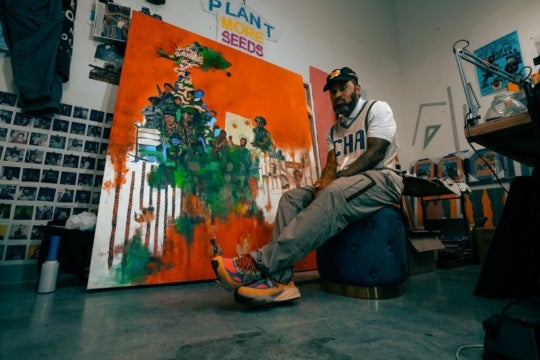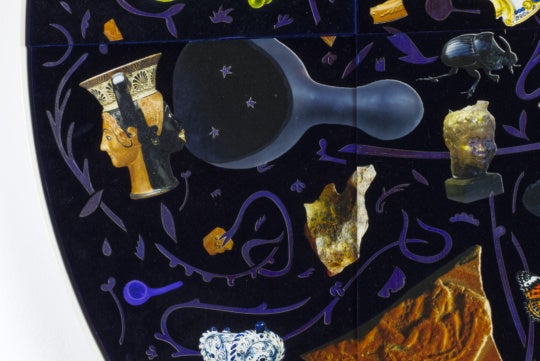
The exhibition The Ocean Casts the Deepest Shadow, on view at Poem 88 through February 2, culls primarily from the past two years of work, mostly paintings, by the established Georgia-based artist EK Huckaby, now with more than 30 years of solo and group exhibitions under his belt.
There are no human figures in the paintings, though the human presence—or perhaps more accurately, the human absence—is deeply felt. Even in their undifferentiated anonymity, many details suggest the lives of another era: a stack of anonymous parcels, each twined just so; lightbulbs glowing beneath lampshades; a brightly lit cloth hiding the contents of a picnic basket set on a dark and obscure background; a long row of ironing boards.
Huckaby famously mixes his own paints, pigments, and glazes by hand (though the occasional references to him as an “alchemist” in press and gallery materials seem a bit of a stretch), and the varnishes intrigue the most in this particular show. The lightbulbs, rusted horseshoes, old empty sick beds, and crumpled flags appear underneath a lustrous layer often warbled like antique glass, giving the depicted scene a floating, encased quality, like things caught in amber.



The surfaces glisten with liquid newness, though what’s underneath seems to exist in some airless past, frozen into the process of collection, depiction, and storage. In the largest work, Lineage, outdated lightbulbs are arrayed like extinct creatures in a natural history diorama, an elegant round architectural window frame displaying evolution’s losers. The canvas’s surface is covered with mica, giving the work a fractured, sparkling, translucent quality and its interior an unusual, wan light.
The subject matter and the earthy tones might suggest dust, decay, and the passage of time, but there’s a more overarching—and sadder—note of fixedness, of objects giving up activity in exchange for longevity. This message gains its simplest iteration in the 1991 sculptural work Firecrackers in Glue, displayed alongside the newer paintings, in which rows of vintage firecrackers are preserved, but made unlightable encased in clear glue.


The term “Southern Gothic” often comes up in considerations of Huckaby’s work, and it’s certainly apt, though I think his work doesn’t depend on narrative, the fantastic, or the macabre in the way Southern Gothic literature often does. There’s a matter-of-fact focus on ordinary objects in his work—a sense of discovery and wonder at their inherent spookiness and mysticism—rather than an interest in seeing things transformed by grotesque, extreme, or sinister circumstances. If there are human beings on the margins of these paintings, they are not blazing with demented passions or historicity; they live faintly. The painting Oxygen, for example, depicts an oxygen tent covering a sick bed in an anonymously spare yellow room.
Similar to his technique in Oxygen, the brushwork in Huckaby’s representational paintings occasionally shows a simplicity, looseness, and crudeness when viewers might expect more clarity, specificity, tightness, and focus. There are only a handful of entirely abstract works in the exhibition, but they’re the most technically accomplished and the most captivating in their detail. The strongest work, Dissociative Domesticity, 2010, combines the detailed, decaying patterns of Huckaby’s abstraction and the lovely impulses of his representational work: rows of lamps glow beneath a resin-like patterned surface with a phantasmal interiority.
This, I think, shows the strange, divergent impulses at the heart of Huckaby’s work: The Ocean Casts the Deepest Shadow is a collection without classification, an entombing without death, memorializing some past that is never named.
EK Huckaby’s exhibition continues at Poem 88 through February 2.




